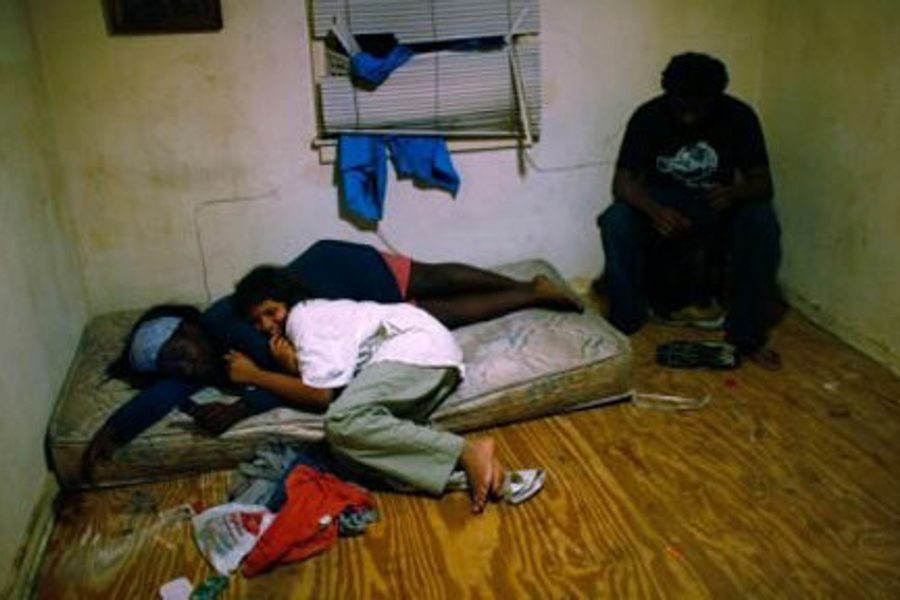
For millions of American households, the recession has turned the once unthinkable into inescapable reality: suddenly finding themselves out of a job, then falling behind on the rent, and finally, losing everything.
New York City’s exploding homelessness crisis is a case study in how new forms of hardship are reshaping the country’s social landscape.
The New York City Coalition for the Homeless reports that on any given night, 39,000 New Yorkers are huddled in city shelters. Though urban homelessness is typically associated with chronic drug users or the mentally ill, New York’s homeless now include some 10,000 families, with more than 16,500 children.
The trend marks a 45-percent growth in the homeless population since fiscal year 2002, despite Mayor Michael Bloomberg’s high-profile efforts to revamp the shelter system.
While previous downturns have been more severe overall, the coalition says “the current year is the worst on record for New York City homelessness since the Great Depression of the 1930s.”
Yet the shelter numbers are just a crude snapshot of the scourge. Many homeless people see shelters as so inhospitable that they opt for the streets instead. And many may be overlooked in official tallies because they are “doubled up” with friends or relatives. Often, children must turn to schools, not shelters, as the closest thing to home, clinging to school-based aid programs as their parents struggle for stability.
And then there are those for whom homelessness is just one overdue bill away — the families who are cleaning out the shelves at food pantries to juggle overwhelming debts. A recent national survey of food banks by Feeding America found a safety net in tatters:
99 percent of all participating food banks reported a significant surge in demand for emergency food assistance over the past year… the increase is particularly driven by first-time users of the food assistance system (98 percent of food banks) and more people who have recently lost their jobs (92 percent).
If you have trouble imagining the trauma and humiliation of not having a roof over your head, so do many of the homeless, at first: formerly middle-class parents may be stunned that they’re choosing tonight between sleeping in a car or piling into a motel room, or skipping a few meals to pay for their kids’ school supplies.
The Washington Post’s profile of the Vasquez family in Virginia, who moved from a comfortable townhouse to a shelter, reveals a shock of disbelief in the face of sudden poverty:
At the shelter, every space is shared: the television room, the playground, the dining room that resembles a school cafeteria. To hold hands in the bedroom where the five members of the family sleep, Yolanda and Ron must reach across the gap between their beds.
During any other time, the Vazquez family’s experience might seem an extreme example. But area shelters report that since the recession started, they’ve seen schoolteachers, computer technicians and interior designers walk through their doors.
So more working Americans are watching the economic security they once took for granted crumble faster than they can comprhend. The Homeless Employment Survey, conducted by the Sacramento Ending Chronic Homeless Initiative, indicates that the vast majority of those surveyed were unemployed but wanted to work. And one in ten were actually working while homeless.
Among the top barriers to employment were a lack of skills, education or training, as well as disability or health issues. And yet this was not an unskilled population: “About one-third stated they had computer [33.5%]; hospitality [32.8%]; construction [32.2%] and retail skills [29.1%].”
Many cited homelessness itself as the biggest obstacle to holding down a job.
That tragic catch-22 seems to be playing out in New York City. Advocates say that due to time limits and other constraints on housing assistance, the social service system ironically ends up hindering homeless families from working toward self-sufficiency.
The recession has widened the continuum of distress that undergirds modern homelessness: the economic vulnerability bred by a lack of affordable housing, limited educational opportunities, a broken healthcare system, and weak community infrastructure. Though the federal stimulus provided some emergency homeless assistance, lawmakers haven’t owned up to the problem as an entrenched social crisis. The sense of denial felt by some of today’s newly homeless reflects the willful ignorance of Washington.
Homelessness may be the extreme end of the recession, but it’s closer than you may think. If this recession has taught us anything, it’s that while we’re increasingly divided by inequality, we’re also leveled by common hardships in ways we never imagined before.
Michelle Chen is a contributing writer at In These Times and The Nation, a contributing editor at Dissent and a co-producer of the “Belabored” podcast. She studies history at the CUNY Graduate Center. She tweets at @meeshellchen.








